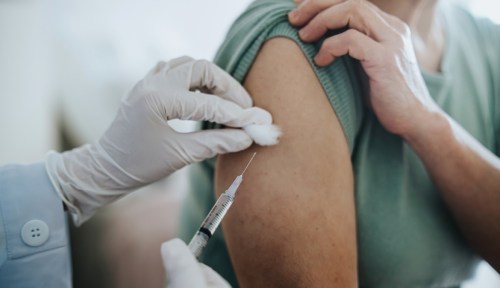Our editors independently select these products. Making a purchase through our links may earn Well+Good a commission
How To Track Your Period Naturally (Like, Without an App)
Learn how to track your period with four totally doable methods. From paper calendars to period tracking apps, we've got you covered.

When your period arrives should be a totally private and personal matter. But thanks to the deterioration of reproductive rights around the country, how to track your period—whether with an app, a digital record, pen and paper, or another method—is a question that’s more fraught than it should be.
Experts in This Article
associate professor of family medicine and obstetrics and gynecology at the University of Washington
former nurse practitioner working with Favor (previously The Pill Club), a birth control delivery service and current program manager at Midi Health
functional medicine doctor and founder of VibrantDoc
OB/GYN and medical advisor for Flo Health
Why the potential need to choose your period tracking method of choice carefully? The legal ramifications are still unfolding for people with uteruses following the Supreme Court’s decision to overturn Roe v. Wade, the pivotal court case that established the constitutional right to abortion. One of the potential things affected by this ruling, which now turns the question of legalized abortion over to states to handle, is digital privacy rights. Experts worry that states with outright bans on abortion may start to monitor their residents’ location, search history, and app data (including period tracking apps) in order to build a case against folks allegedly seeking reproductive services. So in addition to finding whatever period tracker works best for you, you might want to consider your privacy and the regulatory landscape where you live.
Having a cycle tracking app on your home screen is common. Millions of people worldwide have downloaded apps like Clue, Natural Cycles, and Flo to help them stay in step with their menstrual cycles. Folks use these services as a birth control method, as way to track their periods, to know whether an early period or a late period is cause for concern, as a family planning tool, and to simply understand their bodies in a more complex way. But now, that private information may be weaponized in states where abortion is or will soon be banned. So if you’re wondering how to track your period without an app, know that your inclination is valid.
While it’s worth noting that some of these period tracking apps have already taken steps to privatize your data, it’s totally understandable if you’re ready to take your everyday, reproductive health information offline. Below, we asked medical professionals for their best strategies for keeping tabs on where you are in your menstrual cycle—and how to use that information to empower you in your health decisions.
Understanding the basics of the menstrual cycle
Before we get into strategies for tracking your menstrual cycle, it’s important to know the basics on how said cycle actually works. Per the U.S. Department of Health and Human Services, the menstrual cycle is the hormonal process a menstruating person’s body undergoes each month to get ready for a pregnancy.
“The menstrual cycle is divided into four phases, starting with menstruation and ending with the luteal phase,” says Erin Flynn, DNP, FNP, a nurse practitioner formerly with reproductive delivery services company Favor. Let’s review them:
- Menstrual phase: “The menstrual phase, or menstruation, of the menstrual cycle is when you get your period,” says Flynn. Once your body’s progesterone levels drop, it triggers the shedding of the uterine lining. “This phase lasts for the duration of your period,” Flynn adds. The first day of your period is also considered to be day one of your menstrual cycle.
- Follicular phase: This phase lasts from the moment your period ends to when you start ovulating, or on day six through 14 of an average menstrual cycle. During this time, your body ramps up its production of estrogen to thicken the lining of your uterus in order to house a fertilized egg. Another hormone, follicle-stimulating hormone (FSH), helps mature an egg in your ovaries.
- Ovulation: Once your estrogen levels get high enough, your brain releases a hormone called luteinizing hormone (LH), which triggers ovulation, aka a mature egg being released from the ovaries with the possibility of being fertilized. “Anywhere from day 11 to day 16 [of a menstrual cycle], people can get pregnant,” says Emily Godfrey, MD, MPH, an associate professor of Family Medicine and Obstetrics and Gynecology at the University of Washington.
- Luteal phase: The luteal phase occurs if a released egg doesn’t get fertilized, and eventually results in all of your hormones plummeting. This triggers PMS symptoms you may recognize like extreme fatigue before your period, mood swings, sore breasts… you know the deal. The low hormone levels force your uterus to shed its lining, resulting in your period, which starts the cycle all over again.
How many days is a normal period?
The average menstrual cycle lasts 28 days, but cycles that last anywhere between 21 to 35 days are technically considered “normal.” This range of normalcy is important for a couple of reasons. First, having a regular cycle is a good indication of overall health, and second, having a predictable cycle gives you the best chance at accurately determining when you’re ovulating. In other words, having a consistent cycle helps you accurately predict the window of each month when you’re likely to get pregnant—and make decisions about sex from there (like abstaining or using back-up protection like condoms during your fertile window if you don’t want to get pregnant).
However, not everyone has a typical period, and that’s where period tracking can get dicey. “If people aren’t utilizing anything to prevent pregnancy and don’t have a normal menstrual cycle, it’s going to be very hard to predict your time of ovulation,” says Dr. Godfrey. (And in turn, make it hard to know when you’re going to be fertile.) For example, folks with polycystic ovary syndrome (PCOS) may have more than 35 days between their periods (meaning, they only have about nine periods per year), making it difficult to know exactly when their fertile windows are in a given month.
How do you calculate when your next period will be?
Once you have been tracking your period for six months, you’ll be able to determine your average cycle length. If you have a 28-day cycle, add 28 days (or four weeks) from the first day of your period. So if the first day of your period most recently came on the first day of the month, the 29th would be the first day of your next period.
So, do you count 28 days from the start or end of your period?
You count 28 days (or whatever the average length of your cycle is) from the start—the first day—of your period.
Why does my period date change every month?
The determining factor for variations in the length of your menstrual cycle is how long your follicular phase lasts, Tiffany Pham, MD, an OB/GYN and medical advisor at Flo, previously told Well+Good about menstrual cycle length. Ovulation only begins once an egg has matured in your fallopian tubes, and some months, eggs will mature faster than others. There are other more minor factors, like having sex close to the start date of your period, that could make it come sooner.
Having a cycle that varies in length by a few days from month to month is not a cause for concern. If there are significant differences from month to month, and they happen for several months, you may want to consult your doctor. However, by and large, “it’s actually fairly normal for your period to fluctuate from month to month,” Pham says. “It’s actually more common for that to be the case than for people to have 28-day cycles every month.” Other factors like being sick can delay your period, or even being stressed for long periods of time.
How effective is period tracking?
Proponents of period tracking like it because it’s very low cost, doesn’t require a prescription, and is a hormone-free method of contraception. Many people also find keeping tabs on their cycle empowering in that they know what’s going on with their cycles (and hormones) each month.
Period tracking can also inform you when your period typically is, which can help you detect a potential pregnancy early and ensure you get the care (prenatal or abortion) you want and need as soon as possible. That’s critical in states that have banned abortion after a specific time window like six weeks, for example, since pregnancies are calculated from the first day of your last period. (So someone with a 28-day cycle who has a positive pregnancy test on the first day of their missed period would already be considered four weeks pregnant.)
However, period tracking is not fool-proof if you’re using it to prevent pregnancy. The method is vulnerable to human error (like miscalculating your fertile window) and typically requires daily tracking and recording of various metrics, depending on which method you use. Per Planned Parenthood, fertility awareness methods like cycle tracking are 76 to 88 percent effective at preventing pregnancy, on par with the pull-out method. (If you don’t have a regular period, cycle tracking is likely even less effective.) By comparison, condoms are 85 percent effective at preventing pregnancy, the pill is 91 percent effective, and the IUD is 99 percent effective. So if you’re a person with an irregular cycle or who would struggle to keep track of daily metrics, period tracking is likely not the best birth control method for you.
How to track your period without an app
Now that you’ve refreshed your memory on the menstrual cycle, we’re ready to discuss options. Below, you’ll find three of the best no-tech, period-tracking strategies out there. Just remember: If you don’t feel safe talking to a physician in your current zip code (totally understandable), online services such as Favor and the Planned Parenthood chatting tool can help you get the answers you need.
1. The calendar method
The calendar method is a simple, easy way to keep an eye on your menstrual cycle—but it does require some work at the beginning. According to Planned Parenthood, you’ll need to keep track of the length of your menstrual cycle (noting the start date of your periods and the number of days between them) for at least six months before you start using this method as birth control.
Next, you’ll need to do a little bit of math to figure out your fertile window, aka the days you could ovulate and get pregnant. “[S]ubtract 18 days from the length of your shortest cycle to figure out the first day you’re most likely to be fertile, and subtract 11 days from the length of your longest cycle to figure out the last day you’re most likely to be fertile. For example, if your period lasts 27 days, you are most likely fertile from day 9 to 16,” explains Flynn. (Head to Planned Parenthood’s website for step-by-step instructions, including a diagram you can draw out on paper to make your tracking a bit easier.)
The more you track on your calendar, the more intel you’ll have for when to expect various symptoms surrounding your period, too. So in addition to documenting start and ovulation dates, you can also note down symptoms like cramps, bloating, headaches, as well as datapoints like how heavy your flow is, incidences of pain, cravings, or anything else you experience. That way, you’ll be able to understand what’s normal for you, and more easily identify if something is out of whack.
2. Use a basal body temperature (BBT) chart
Your basal body temperature indicates the temp of your body when it’s fully at rest, and according to Dr. Godfrey, it’s a solid family planning option. Your chances of getting pregnant are the highest in the few days before your body’s temperature rises. And thus, you can plan sex carefully around those days depending on your personal reproductive goals.
That said, BBT can be a bit of a pain because you must take your temperature first thing when you wake up. (That means before you go the bathroom, check your phone, or turn the coffee pot on.) This habit can be hard to create in the beginning, so you may have to work on it (and use backup contraception, if you’re trying to prevent pregnancy) before it becomes 100 percent reliable. You have to track your temperature consistently for at least three months before you start using it as contraception.
You can download and print a free BBT chart here.
3. CycleBeads
Dr. Godfrey likes to recommend CycleBeads, a visual family planning tool that emulates a rosary. Starting at day one of your cycle, you’ll simply slide the beads clockwise as the month progresses. It relies on the “Standard Days” method, which is a simplified version of the calendar method, and was developed by researchers at Georgetown University.
Each bead is color-coded, and tells you something about your cycle on that particular day. “They literally indicate the first day of bleeding with a red marker on the cycle bead, and then there are 12 white beads that indicate you’re not supposed to have intercourse if you are using that method to prevent pregnancy,” says Dr. Godfrey. There are also blue beads, which represent days where you’re highly unlikely to get pregnant.
These beads have been clinically tested, and are more than 95 percent effective when used correctly and 88 percent effective with typical use. However, it may be a good idea to use them in tandem with other birth control methods until you’ve made bead-tracking a habit, or know for sure that your cycle is regular. It’s also typically not recommended for people with cycles shorter than 26 days or longer than 32 days.
How to track your period with an app
Period tracking apps run the gamut from free to paid, reliant on manual entry or automatic biometric data collecting, bare bones to powered by AI, and beyond. While how you track your period with an app may vary from service to service, generally it involves entering the start and end dates of your period. It can only get fancier from there.
“I wouldn’t worry about tracking on the days when you don’t notice anything unusual, but when something new happens—even if you aren’t sure whether it’s related to your cycle—record it,” Stacie J. Stephenson, DC, CNS, a functional medicine specialist and author of Vibrant: A Groundbreaking Program to Get Energized, Reverse Aging, and Glow, previously told Well+Good about the benefits of tracking your cycle. “It could be something uncomfortable like a menstrual migraine or something great like a boost in libido or a high-energy, super-productive day. The more information you track, the more easily you can determine patterns and once you see those patterns, you will get a better idea of what’s coming and when.”
Considering these questions will help you pick the right app for you.
1. Decide what kind of data you want to input and get insights about
Tracking your period with an app means entering—you guessed it—the start of your period into the app. But things can get more complicated from there. If you want more insight into what to expect during your cycle, look for an app that allows you to enter other data like flow level, period color, mood, arousal, breast tenderness, postmenstrual syndrome (which is basically like getting PMS after your period), and more. Some apps will also incorporate biometric data. For example, Natural Cycles requires users to submit basal body temperature data, either by taking their temperature with a connected thermometer, or with the Oura ring. This temperature data can help you predict ovulation and when your period will come.
2. Consider whether you want a paid or free option
While many of the best standalone period tracking apps require subscription payments to make the most of their features, an increasing amount of services will let you track your period for free. For example, the Apple Health app has an impressively robust free period tracking feature that comes standard on iPhones these days. However, a paid option might come with more ways to track biometric data from devices and community features. Other apps may be free, but also rely on data collection and advertising to provide you with services. Which is why, if you’re considering going with a specific app, it’s a good idea to…
3. Read up on the app’s privacy policy
How a period app stores its data, what its third party data-sharing policies are, and what kind of data the app collects about you (for example, does it track your location?) are questions you may want to consider. Ultimately, the level of data you’re comfortable sharing is a personal choice.
4. Take your goals into account
Some period tracking apps are focused on period and symptom prediction. Others are oriented toward providing contraception, while others aim to help you become pregnant. There are many apps that say they can do it all, but finding the app that’s most closely aligned with your needs will help you avoid paying for unnecessary features or leaving you wanting more.
Sign Up for Our Daily Newsletter
Get all the latest in wellness, trends, food, fitness, beauty, and more delivered right to your inbox.
Got it, you've been added to our email list.










